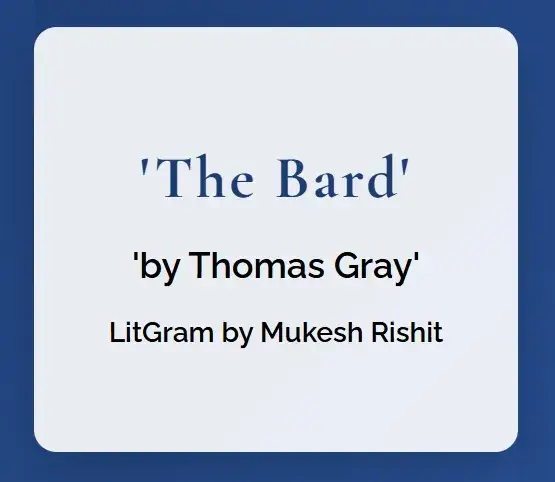Introduction
Thomas Gray’s narrative poem “The Bard” (1757) is one of the most haunting and evocative works of mid-18th-century English literature. Written in blank verse, Gray’s poem dramatizes the fall of the last Welsh prince, Edward II’s bard, as he curses Edward’s conquerors. With its fusion of classical allusion, medieval romance, and prophetic tone, “The Bard” stands apart from Gray’s elegiac odes and heralderizes the Romantic sensibility that would soon flourish in England. In this post, we explore:
- The historical context surrounding “The Bard”
- The poem’s structure and stylistic features
- Major themes such as national identity, prophecy, and grief
- Its lasting significance in English literature
- Original insights to enrich your understanding
Historical Context of “The Bard”
Gray composed “The Bard” in the summer of 1757 but published it only posthumously in 1775. The poem was inspired by the antiquarian research of Owen Jones and his Welsh Companion, The Myvyrian Archaiology of Wales (1801-1807), though Gray had access to earlier translations of Welsh chronicles. It captures the legendary moment after Edward I’s conquest of Wales (1282–83) when the last native prince, Llywelyn ap Gruffudd, has fallen—and the court bard, as chronicled in medieval romance, rises to prophesy the doom of Edward’s line.
“Where shall he rest? where bend the tuneful string,
O, bard of Cambria, on what Gothic shrine?”
These opening lines, added by Gray, evoke a sense of loss and dislocation. They frame the bard’s solitary struggle against the tide of conquest and prefigure the Romantic ideal of the alienated poet.
Structure and Form
Blank Verse
Gray chose unrhymed iambic pentameter (blank verse) for “The Bard,” a form popularized by Milton’s Paradise Lost. This choice lends the poem an elevated, epic quality suited to its solemn subject.
Division into Five Stanzas
The poem unfolds in five stanzas of unequal length:
- Invocation and Address (lines 1–14)
- The Conquest Scene (15–38)
- The Bard’s Lament (39–68)
- Vision of Prophecy (69–103)
- Curse and Departure (104–146)
Each section intensifies the emotional and dramatic stakes, moving from elegiac reflection to prophetic fury.
Themes in “The Bard”
1. National Identity and Resistance
Gray’s poem emphasizes Wales as a land of ancient song, resisting English dominion:
“Loud shall the vexed Cymric trumpet blow,
Though broken be the warrior’s sword.”
The bard embodies collective memory and the power of poetic tradition as a form of cultural resistance. Gray suggests that even in defeat, the spirit of a nation survives through song.
2. Prophecy and Supernatural Vision
The heart of “The Bard” lies in the bard’s vision of retribution:
- Mythic Monsters: The moon-lit phantom of dragons and phantoms symbolizes the wrath of history.
- Curses as Creative Act: Gray presents the poet’s curse as an act of imaginative creation that can shape political destiny.
“An Earthquake rock the tyrant’s seat,
And wrap the palace in the winding‐sheet.”
Here, the poet’s visionary power merges with elemental fury—an early foreshadowing of the Romantic valorization of imagination.
3. Loss, Grief, and Mourning
The opening invocation establishes grief as a central mood: the French Odes of Gray likewise merge personal and national sorrow. The bard’s lament reflects:
- Communal Mourning: Not just his private loss but the loss of an entire people.
- Elegiac Tone: Gray’s characteristic lament, reminiscent of his “Elegy in a Country Churchyard.”
“Cold is the turf, and damp the mould,
That wraps around his weary head!”
This elegiac strain anchors the poem’s more dramatic moments in deeply felt sorrow.
Stylistic Features
- Allusion: Classical references (e.g., Cymbeline) enrich the tragic framing.
- Imageries of Nature: Grey skies, storm-racked castles, and moonlight emphasize the poem’s somber mood.
- Personification: Wales is portrayed as a living entity, mourning alongside its bard.
- Contrast: The dignified language of prophecy set against images of martial ruin creates tension.
Original Insights
To deepen engagement, consider how Gray’s own historical moment—Britain’s growing empire—mirrors the poem’s narrative:
In an age of colonial triumph, Gray’s “The Bard” reminds us that every conquest carries a hidden elegy; the poet, not the soldier, preserves the memory of the fallen.
This original observation positions Gray as a prescient critic of imperial hubris.
The Poem’s Significance in English Literature
Prelude to RomanticismGray’s emphasis on imagination, nature, and historical melancholy anticipates poets like Wordsworth and Shelley.Evolution of Narrative PoetryUnlike the classical epic, Gray’s poem fuses personal emotion with national history in under 150 lines.Influence on Later Writers
Byron, Scott, and Tennyson drew on themes of national decline and poetic prophecy pioneered here.
Gray’s “The Bard” stakes out a vision of poetry as prophetic voice—an idea that resonates through the next century of English letters._
Conclusion
Thomas Gray’s “The Bard” remains a powerful fusion of elegy, prophecy, and national lament. By examining the poem’s historical roots, formal qualities, and thematic richness, we appreciate how Gray pioneered a poetic vision that bridged the Enlightenment and Romanticism. Whether you’re a student, scholar, or poetry enthusiast, “The Bard” rewards deep exploration—each reading kindles the ancient flame of bardic song.
Want more literary analyses?
Subscribe to our blog for weekly explorations of classic and contemporary poetry!


